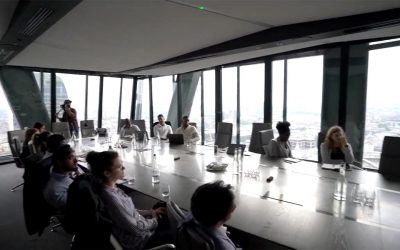This past summer I was selected to be part of the Future VC programme and what a journey it was. Future VC was born from the fact that most people who have managed to break into the venture capital industry have very similar profiles. Diversity VC research shows that today’s London VC industry is 71% male, 74% white, and that 20% of VC professionals attended one of four universities – Oxford, Cambridge, Stanford, or Harvard.
The programme was launched in 2019 and provided 30 participants with a series of workshops delivered by some of the top venture capitalists, as well as a 5-week internship at 20 of the most highly sought-after VC firms in the UK. It was a massive success, and it began to move the needle in adding more diversity into the VC ecosystem.
Then the unexpected happened. CV-19 swept the globe and many wondered whether Diversity VC, who created the programme, would still run it this year. And if they did, how would it work, and can it deliver something that can make a real impact for the people taking part?

Photo by Javier Allegue Barros
The Diversity VC team certainly lived up to their name, they decided to forge ahead and opened it up to the world. Nearly 400 people from 177 cities participated in this year’s modified remote programme. The programme draws talent from communities are that under-represented in VC, whether they are a minority, or living in a location that is not an investment hub or from a non-traditional career background.
Instead of the traditional “in-person” format, the cohort attended a number of online masterclasses every week to increase our knowledge of VC, what they do, what drives them and an understanding of what a career in the industry might be like. They were also paired up with 300 volunteer mentors (investors from funds in Europe and the US) from around the world who worked with participants directly or in small groups, helping to answer their questions, demystifying the world of VC and supporting each of the cohort’s own personal journey.
In this post, I am going to break down what we had learnt and highlight some of the sessions that particularly resonated with me. But before we get to that, I wanted to talk a little bit of the community aspect of the programme. I was simply blown away by the passion, the raw talent and the proactiveness of the cohort. Many people posted introductions in the LinkedIn group, some reached out independently and connected, Slack channels were created, all this even before the official start date.
Throughout the programme, I have spoken to people in all walks of life from London to Boston. What also struck me was the number of operators in this cohort; some wanted to understand how a VC thinks to prepare for their fundraising, others wanted to join a VC fund after their start-up journey and some were simply curious about VC as an industry.
There were 44 wonderful speakers that gave talks and each of them was expertly delivered. They were insightful, practical, and offered much wisdom. Here is a snippet of the 7-week crash course on how to VC.

Week 1
Brief History of VC
Presented by: Michael Tefula (Oxford Seed Fund)
Key Lessons:
- Queen Isabella I of Spain was one of the earliest VCs. She would back explorers, such as Christopher Columbus, with capital so they could voyage along the westward routes to Asia, which were high risk ventures back in the day.
- Modern VC is only around 80 years old, and it evolved from the whaling industry in the 1800s. Some of the terms are still used today, such as the concept of carry.
- In the 1940s, early VC pioneers pursued social returns alongside economic returns. New risk capital was raised to stimulate the economy and achieve long-term capital gains through investment in innovative businesses, but to also generate social benefits. Basically growing their way out of the Great Depression.
- The average VC fund fails to make money, but winners win big. The Power Law drives the VC industry where a small % of a VC fund’s investments will yield the majority of their returns.
VC 101
Presented by: Henrik Wetter Sanchez (Playfair Capital)
Key Lessons:
- The journey to fund a company is summarised as follows: (1) Sourcing, (2) First Meeting, (3) Due Diligence, (4) Investment Committee, (5) Legals, (6) Closing and (7) Portfolio Support.
- Sourcing – Consideration of the investment criteria (Stage, Sector, Business Model) and determining where to look for start-ups (your network, events, inbound, outbound). A junior member of the investment team typically spends ~20–30% of their time sourcing for new deals.
- First Meeting – What needs to be covered in the first meeting with the founder(s) to assess whether it is a venture-backable company (team, problem, solution, market, traction).
- Due Diligence – Follow-up questions on the first meeting, assessing materials in the data room and checking references from customers and former colleagues.
- Investment Committee – Its decision time. Partners, principals and/or associates (fund dependant) gather to debate the thesis for investing, the key risks and deal terms.
- Legals – The paperwork (term sheet, Investment Agreement, Articles of Association) is put together and issued to the founder(s).
- Closing – This is where you complete the investment; legal paperwork is checked and signed, cash is transferred to the company and usually a press announcement.
- Portfolio Support – This is where the real work starts; supporting and monitoring the company as a Board member, shaping the Go-To-Market (GTM) and sales strategy, helping with hiring structures and attracting key hires through network referrals and tracking financial metrics such as runway, burn rate, budget vs actuals, milestones, Key Performance Indicators (KPIs).
Fund Mechanics
Presented by: Suranga Chandratillake (Balderton Capital)
Key Lessons:
- Limited Partners (LPs) are the primary source of capital in the VC industry. They can be pension funds, endowments, family offices, funds of funds, corporates or public funds such as Sovereign Wealth Funds.
- VCs are remunerated by fees (1–2.5% per year over the lifetime of the fund), carry – after the original capital is returned, anything above is ‘profit’ (usually 20–30%) but General Partners (GPs) also have to put in capital commitments – skin in the game (usually 1% from each GP).
- VCs have to, at minimum, return 3X the fund over an 8–10 year period, yet <10% of firms hit this target.
Alumni Future VC Experience
Presented by: Cassandra Kanaki (Accel), Akash Bajwa (Augmentum Fintech) & Tunde Adekeye (Icebreakers.vc)
Key Lessons:
- There were many useful tidbits and personal experiences that came out of this session with last year’s Future VC alumni. Here are some of the key ones:
- First Time Funds that just raised capital are more likely to hire for roles.
- Develop Founder(s) Relationships and add value after they have fundraised whether it is helping them speed up their sales cycles or hiring key talent.
- Form An Outsider View – Come up with your initial (maybe conventional) views but then take a few steps back and invert your thinking and see if any unforeseen insights drop out.
- Do market analysis case studies – what are the headwinds/tailwinds, why should the fund invest in this, produce short deal summaries or investment memos.
- Start an investment decision journal – capture all of the conversations you’ve had with founders, write down the things you like/don’t like about the company, what are the assumptions you are making, and then ask yourself if you have been biased.

Photo by Dan Gribbin
Week 2
Spotting Outliers
Presented by: Harry Briggs (OMERS Ventures)
Key Lessons:
- VC fund returns are driven by outliers as per the Power Law, as we learnt from Week 1, only 3% of deals drive 50% of returns.
- So how do you spot outliers? Harry explained the 8 qualities he looks for in a founder.
- Earned Insight – They worked really hard on something different, often overlooked to give them a unique insight.
- Inspiring Vision – Something that is bold, considered crazy and not many people working on it. You feel they can inspire customers, staff and investors with their vision.
- “Misfit” With Something To Prove – They don’t fit into the conventional construct. They are not part of the establishment as those that are, tend to have incompatible outlier characteristics. Often had an odd childhood. Perhaps moved around a lot. Driven by adversity or set-back.
- Deep & Broad – They have the ability to operate at a high level but equally comfortable drilling incredibly deep into their business and industry.
- Insatiable Learners – They have a growth mindset and you can see how much progress they have made in the last 6–12 months.
- Talent Spotters & Talent Magnets – They can identify high potential and high performing people, but are also able to convince them to join their team and place them in the right roles.
- Speed & Urgency – They don’t rest on their laurels. They continuously drive their business forward and retain a healthy sense of paranoid when it comes to competitors and strategic inflection points. They usually get back to you really quickly!
- Extreme Resilience - They are unbelievably determined. Despite facing adversity and setbacks, they show grit and always find a way through.
- Finally, Harry left us with some additional observations. Relating to Earned Insight, what are the areas they are passionate about? What are the things they have studied or understand that they know more about than anyone? Do they have the capability to learn to lead? Do they have the ability to engage you or inspire you? Look for a certain level of intensity. Look for quiet confidence.
Sizing Market Opportunities
Presented by: Tom Wehmeier (Atomico)
Key Lessons:
- Markets Matter To VCs – When a great team meets a lousy market, market wins. When a lousy team meets a great market, market wins. When a great team meets a great market, something special happens. However, it is easy to underestimate markets, or look in the wrong places or to overlook markets entirely.
- Identifying Overlooked Markets – Reasons include its too expensive to enter, too complex to serve, too small or hard to reach. And timing matters.
- Problem Size – It’s easy to fail to understand the real problem a company is solving. Only by arriving at the core problem that’s being solved, can you then assess the market opportunity. Creating new markets from scratch usually provides the largest returns but it is much harder to succeed.
- Market Size Of Tomorrow – Don’t be afraid of markets that don’t exist at scale today. Account for the ability to extend a product set to move beyond the initial target market into adjacent markets. Consider selling new things to the same customers, selling to a new set of customers entirely or selling new things to new customers. The best teams will naturally find the path to expand beyond their core markets.
- Monopolising Segments – Markets that may appear ‘small’ (<$1Bn) might still produce outsized outcomes. The key to an outsized outcome is dominating or monopolising a defined market. The benefits of being the dominant player are obvious (valuation premium, pricing power, low CAC, high retention). However, markets that may appear to be dominated by monopolies may still have white space. They look to be homogeneous but are actually made up of many parts or segments.

Photo by Karine Germain
Week 3
Due Diligence
Presented by: Lillian Li (Eight Roads)
Key Lessons:
- DD enables an investor to identify, quantify and mitigate risks hence determine both the current and potentially future value of a business.
- DD is usually broken down into; market, competition, product, team, financials, valuation & deal dynamics and exit but the mindset going into DD should be “How are you going to grow to a $100M+ business?” and “How do we make a lot of money over the course of 7–9 years?”
Transaction Economics
Presented by: Itxaso Del Palacio (Notion Capital)
Key Lessons:
- Itxaso took us through a worked example of a typical investment deal. She explained how it is structured, the economics of an exit event and what it returns to investors and founders. She went through concepts such as pre-money, post-money, ownership dilution, option pool, how liquidation preferences work and how anti-dilution terms work.
Soft Skills for VC
Presented by: Seth Pierrepont, Ulrika Werdelin, Holly Bennett & Noa Maxwell (Accel)
Key Lessons:
- VC Success Factors – Has deep curiosity about technology, is a hustler & self-starter, is authentic with an ability to connect with founders, able to form conviction & take risks, have clarity of thought and is humble with a learning mindset.
- Building an effective network is important to any VC, how are some steps on how to do this:
- Clarify Purpose – Be intentional about who you want to connect with and for what purpose to allow a clear focus. What value can I bring to the interaction? What skills do I bring?
- Develop Your Elevator Pitch – Have ready a short & articulate summary of what you do and what you want to do.
- Be Prepared – Research the person’s background; topics of mutual interest, connections with mutual people, read their blogs, news articles about them and any recent news of their portfolio companies.
- Listen More Than You Speak – Pick up on their conversational clues to help with the flow of the discussion; are they fast-paced, fact-driven or do they pause & reflect?
- Ask For Help – If you don’t ask, you don’t get but be clear and concise about the ask.
- Follow Up & Collaborate Generously – Send a thank you note and action any follow up items you had agreed or offered. This will strengthen the relationship.
- Key points when putting together an Elevator Pitch of yourself – It should be around 30s to 1 min. Your audience will be thinking “Do I trust you?” You need to be authentic. Have some data in your pitch, it adds colour and turns it into a picture, it makes it more meaningful. Make a connection, be memorable. Show energy and passion.
- Finally, some more insights from Seth and Noa. People buy people, so be interested in people! Have opinions, and perhaps have a hot take. Use anecdotes “I remember when…” and use metaphors “Like a duck gliding on the surface of a pond…” When assessing a founder, you are looking for resilience and an open mind so you could try picking a fight on a benign matter and feel out their reaction. Do they shut down, or do they recognise the point and still don’t agree with you? Do they have self-awareness?

Photo by Paweł Czerwiński
Week 4
Raising a Fund
Presented by: Check Warner (Ada Ventures)
Key Lessons:
- The journey of fundraising for a fund. Raising a fund requires a huge amount of privilege as you need an investing track record, resources to support yourself during the roadshow and money for the GP commitment.
- Love Your Partner(s) – Your partnership is the most important thing as you will be bound to them for the next 10 years so you have to work well together and it helps to like them too!
- Be Distinctive & Differentiated – You need to be able to answer the LPs on questions like why do I need another fund, why are you different, why will founders pick you, why will co-investors share deal flow with you, what is your strategy in 30s, why couldn’t other funds copy you, why will you be able to lead rounds and why are you the best possible team to execute this?
- Track Record – LPs rarely invest in a new team, rarely investinvests in first time investors, will sometimes invest in first time fund managers, loves to invest in ‘spin out’ teams from existing groups so a track record of some kind is essential.
- Make Investments Whilst Fundraising – It’ll be hard to juggle the two things but it shows momentum and answers the LPs’ questions of what types of companies you will invest in and whether you can get deals done in the new fund. Try using a Special Purpose Vehicle (SPV) to cut down on set-up time and administration tasks.
- Every No Brings You Closer to a Yes – It took 18 months to get to a first close, spoke to hundreds of people so you have to enjoy the journey otherwise you’ll be miserable and quit.
- The Anchor – Focus on your anchor which is effectively your lead investor. They will work with you on the Limited Partner Agreement (LPA). They will help you get the other investors.
- ABR – Always Be Raising, fundraising never stops. On average, LPs have known funds for 2–3 years before investing. Similar to GPs, LPs invest in lines, not dots. Consistent communication is critical.
The LP’s Position
Presented by: Anu Adebajo (British Patient Capital)
Key Lessons:
- LPs are the money behind the money. They assess whether the GPs will make money.
- Team – Have they worked together before? Is it a stable team? Is there diversity? Is there succession planning?
- Track Record – From an individual and collective perspective. What are their realised and unrealised gains? Will they invest to the same strategy? Which team member is responsible for what?
- Strategy – Is it clear? What is the portfolio construction? How do they source for deals? What is their value-add? What is the fund size? What are the macro conditions?
- Fundraising – Have existing LPs re-up and what is the rate? Is there interest from new LPs? What is the distance to the fundraising goal? What are theis the capital market conditions?
- Terms – Is it value for money? What is the management fee (cap or no cap)? What is the carried interest? What is the hurdle (multiple or IRR)? What is the GP commitment?
- Investment Process – (1) New fund proposal received, (2) Initial Call, (3) Meeting(s) with the entire investment team, (4) Due Diligence; references, fund model, legal, operational, on-site visit, (5) Investment Committee; with or without the GPs, (6) Legal Completion; LPA, side letter and (7) Close; advisory board, AGM, quarterly reports, investor consents.
- Why Not Be An LP? A “star” LP is rare, and it is not glamorous, Lower risk means lower return. Virtually no crossover into being a GP.
- Why Be An LP? Opportunity to influence the ecosystem. Get a wider market overview. Risk is absorbed by a portfolio approach. Attractive risk adjusted returns. Help fund the VC franchises of the future. Help fund the high growth companies of the future.

Photo by Jeremy Bishop
Week 5
DeepTech Investment
Presented by: Jack Wang (KEEN Venture Partners)
Key Lessons:
- There are different ‘depths’ of DeepTech investing from self-driving cars to spaceships so you must consider market timing and whether you can exit and return your fund within a 10-year period.
- Whilst DeepTech usually have a tech moat, you have to weigh up the tech moat vs the time-to-commercialisation and time-to-market because it usually takes DeepTech companies longer to find product/market fit.
- Tech By Itself Isn’t Enough — You need a founder who is technical with vision AND commercial skills. Financial traction will be slower than tech-enabled businesses, but margins should be improving over a period of 2–3 years. They can have a vertical or horizontal business model. They can often open source.
- Does having a STEM background help to be a DeepTech investor? Yes, but so does a great network.
- Where to find these companies? Some are backed by early stage specialist funds as most are capital intensive. Research based sourcing helps. Expert scout network is useful, as some VCs track PhDs.
- Is DeepTech B2B only? Not always but often, as being DeepTech is a competitive advantage in order to drive capital efficiency and unit economics.
- Finally, some other insights from Jack. Stay curious, ask “how” and “when” and be product-focused and pain point-focused. Think beyond the buzzwords of AI and Blockchain and read a lot, remember categories like dev-tools, biotech and cyber security are also DeepTech. Don’t be afraid to ask for help or expertise from people more knowledgeable than you.
Impact Investment
Presented by: Dama Sathianathan (Bethnal Green Ventures)
Key Lessons:
- All investments have impact – both positive and negative. Impact investment is defined as “investments made into companies, organisations and funds with the intention to generate a measurable social and environmental impact alongside a financial return.”
- Problems include; rapid urbanisation, climate change, shifts in global economic powers, demographic and social change.
- Shifting Perspectives – Investor and consumer demand is shifting towards more purpose-driven sustainable investing products and services.
- Market size of impact investing was $715Bn in 2019.
- Core Practices – (1) Intentionally contribute to positive social and environmental impact, (2) Use evidence and impact data in investment design, (3) Manage impact performance and (4) Contribute to the growth of impact investing.
- But Impact Measurement Is Complex – There are three widely used methods; (1) Process Methods – tracks the conversion of inputs to outputs over a period of time, (2) Impact Methods – Relates to the outputs and outcomes, and attempts to prove incremental outcomes relative to the next best alternative and (3) Monetisation Methods – works by assigning a monetary value to a social or environmental outcome.
Investing at Series B
Presented by: Richard Anton (Oxx)
Key Lessons:
- Companies raising a Series B round must show evidence of product/market fit, have a repeatable, scalable and profitable growth model and the business is scaling.
- Rate of Return is Different – For growth investors, expecting 3–5X whereas early stage investors expect at least 5–10X and late stage investors such as Leveraged Buy-Outs (LBOs), expect 2–3X.
- Surprisingly, there is less competition in the Series B and growth fund space. Lots of public funds and other capital are going into early stage investments hence there are fewer growth funds out there.
- Metrics – predominantly focusing on customer acquisition and customer retention.
- Customer Acquisition – How long is the payback period? What is the Life-Time Value (LTV) of a customer?
- Customer Retention – Number of customers retained at contract renewal. Net retention needs to be above 100% including up-sell, and taking into account churn and down sell. Typically, 130% is best-in-class as an industry standard.
- Generally, growth investors add less value compared to early stage ventures as the company is at a more formative stage.
- Growth funds has a deep understanding of sub sectors and provide more focus and expertise in these areas. When it comes to investing, they have a more disciplined entry price, conduct deep and comprehensive due diligence, guideguides companies to solidify the growth platform before ramping up investment aggressively and they have strong connections into ecosystems of acquirers and capital markets.
Corporate VC
Presented by: Eva Rez & James McClurg (Sky Startup Investments & Partnerships)
Key Lessons:
- Corporate Venture Capital (CVC) is a catch-all name used to describe a wide range of equity investments exercised by corporations. The two main objectives are (1) developing the strategic capabilities of the parent corporation and (2) providing a source of financial return for the parent corporation.
- Compared to traditional financial return VC funds, CVCs offer strategic alignment, industry knowledge & partnerships & distribution, as a minimum they look for a MVP and some traction, is patient capital and desires less control, usually as a Board Observer.
- There are a number of corporate innovation models such as In-House Innovation – conducting internal R&D with potential spin-offs, Accelerator – traditional accelerator model with a corporate theme focus, Embedded – investing in start-ups from the balance sheet to support strategic partnerships and VC Fund – more VC-like with a single corporate LP.

Photo by Nikko Macaspac
Week 6
How to Help Portfolio Companies
Presented by: Michiel Kotting (Northzone)
Key Lessons:
- Do No Harm – Find strategic alignment on the Board. It’s not about being smart or being heard. Understand conflicts of interest and the value of language as brute forcing will lose the trust of the founder(s) and management team, and likely destroy value.
- Founder(s) In The Driving Seat – Because of their proximity to the action, front line staff knows more (in some cases) than the Management Team who knows more than the Board. So listen to them, figure out what is working then set KPIs and track them.
- Rule Of 60/30/10 – This is a framework on how to split your time on thinking about how to run and grow your portfolio company. 60% of your time should be spent on what is working and the most pressing matters, 30% should be spent on experimental things which will become most pressing in 12 months time and 10% on longer term, future pressing matters.
- It’s Lonely At The Top – Be the founders confidant and provide open and honest feedback, even if it’s uncomfortable. It could go something like “What does this mean for our business if this happens?”, “How do we react to his (bad thing)?”, and if you have already developed strong trust, you can attempt questions like “You are really good at these things but not those things”, “Your co-founder is not keeping up” or “You should focus on those areas”.
- The Road To Success Isn’t A Straight Line – Even the best companies struggle and you cannot plan a company by the numbers.
- The Right Level Of Stubborn – It’s not necessarily a good thing if the founders always listen to you as they should know the company and the market better than you but cannot be too stubborn so there needs to be a balance.
- The Sins Of The Former Founder Investor – Cannot be too hands-on and you should get out of their way, so they can build the company. Former operators or founders tend to be over optimistic. If the founders haven’t got it after a while, then they probably won’t get it or they can’t execute.
- How To Have A Life As An Investor – 6–8 Board positions is probably the maximum one can handle and the first couple of years can be more intense as it’s a new relationship. Remember the importance of the other Board members; who does what, who is more knowledgeable in which areas, how they communicate, how they digest information, how they make decisions and build relationships with each of them outside of the Board room. Find your Minimum Viable Involvement so you can still be effective and have a life.
- Fundraising Expertise – More money isn’t always better. You need to figure out how you can match founders with funds and possibly coach them at getting better at fundraising as not all founders are good fundraisers.
- Exit Unicornville – Companies get bought, not sold. Your expertise must be in knowing what the optimal valuations are for each future round and at exit.
Cap Tables
Presented by: Stephan Von Perger (InnovatorsRoom)
Key Lessons:
- The Cap Table is a list of the company’s current stakeholders and the percentage of economic ownership. It also shows the transaction history of previous investment rounds and preview of the upcoming investment round. It can be an internal scenario planning tool for the fundraising process.
- It is used to calculate the following for each round and each shareholder, the investment amount, valuation & price, number of issued shares and fully diluted ownership percentage.
- Priced Equity Round vs Convertible Loan Note – Equity rounds issue shares at a fixed price and convertible notes are loans that convert into shares later on better terms than investors of a priced round. Simple Agreement for Future Equity (SAFE) hashave the characteristics of a conversion note but are not actual loans.
- Not All Shares Are Equal – Common shares for founders, preferred shares for investors and share options for employees and advisors.
- Stephan then showed us how to build a Cap Table from scratch using a spreadsheet.

Photo by Jon Tyson
Week 7
Preparing for Interviews
Presented by: Freddie Birley (Kea Consultants)
Key Lessons:
- VC Associate Role is roughly split into 40% sourcing, 40% execution and 20% portfolio support.
- Show examples of drive, hustle and resilience. What difficulties have you experienced in life, and what did you learn?
- Need to demonstrate a risk appetite and can build conviction on deals.
- They will be assessing if you have the potential to think like us, but also offer something new to the team.
- You will likely be asked to complete two case studies (1) sector deep dive – a high level overview of the market and trends, a review of target companies, top pick from the market and (2) company assessment – should structure your answer to include an assessment of the team, market, product, defensibility and traction.
- Finally, Freddie shared some more of her advice. Think about your unique strengths (network, geographic coverage, product expertise, life experience), a lot of funds look for similar qualities in the founders they back and teams they hire so pay close attention to the “founder qualities they look for”, provide thoughtful motivations, research the fund’s portfolio and have a favourite and least favourite, ensure your investment idea is in line with the fund’s mandate, keep your investment ideas structured and ask questions! Curiosity is key.
Journey into VC — Lessons Learnt
Presented by: Rebecca Hunt & Uzma Choudry (Octopus Ventures)
Key Lessons:
- Core To Any VC role – Build a network, originate deals, win deals and sit on Board of companies.
- Things I Wish I Knew – Be yourself, be human and develop your own style, it’s a people business so be generous with your time and build genuine connections, enthusiasm and passion will trump knowledge, never lose the thirst for learning, don’t be afraid not know or understand, culture is your only long-term defensibility for a VC fund or a start-up.
- Lessons On Network & Origination – Be genuine because you will not click with everyone, be helpful and share deals and insights, be consistent and invest over time, be patient. Stay ahead of market trends so you can see around corners, read and listen – a lot, spend time to understand different markets and business models. Draw on the knowledge of those around you. Don’t miss the cold inbounds. Look where others are not looking, The best deals often not the most obvious ones.
- Winning Deals – Be open, be honest, let your passion shine through. Work out what is really important to you in a negotiation, this will lead to the deal being much quicker and smoother. References will help you win a deal.
- Lessons Learnt On Being A Board Member – there are rarely situations where there is a clear right or wrong, You have to operate in the world of grey but remember you can refrain from an immediate response, never be afraid to ask your team as we are all learning on the job, nothing is personal so take time to digest other behaviours and perspectives, strength and depth of relationships are absolutely key, the founder is not your friend so maintain a professional relationship at all times, be cautious of your influence as founders may assume you know what you’re talking about, you’re always on the record even at social events, being a Board member is a team sport, try to think of the ideal outcome as being the first person the founder calls with good or bad news.

Photo by Austris Augusts
There were many more sessions as part of the programme, but this post would have been twice the length if I included every single one of them so my apologies for leaving out some of the wonderful speakers.
Whilst I had some knowledge of the topics from my time as a founder, the quality of the course materials was excellent, and it gave me a more rounded but also in-depth view of what VCs do on a daily basis. It was one of most valuable programmes I have been on and I now feel more prepared to work in a VC role.
Lastly, I am grateful to Seb Butt for creating the programme, Julia Rabin for organising and running the online masterclass sessions, and Sarah Millar, who led the mentoring programme. A shout-out to Check Warner, Lillian Li and Travis Winstanley for starting Diversity VC, which Future VC is a part of.
A special thank you to Joe Knowles for being my VC mentor – he has been thoughtful, ever so generous with his time and was instrumental in helping me break into the industry (If there is interest, I’ll write a separate post on how I approached the mentoring sessions with him, what I learnt, some of the tactics to get into VC and some experiments we tried).
Future VC will return to their on-site format in 2021, stronger and more ambitious than ever. Based on how well the remote cohort turned out this year, they are also considering how they can engage with a wider remote audience alongside the physical internships. I hear there has been much interest from many funds in the UK, the US, Germany, France and the Netherlands so watch this space.
If you have any questions about Future VC, venture capital or building a startup, you can find me on Twitter or LinkedIn.


